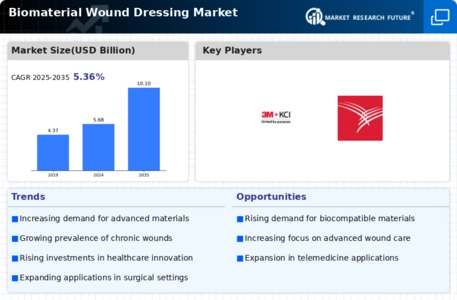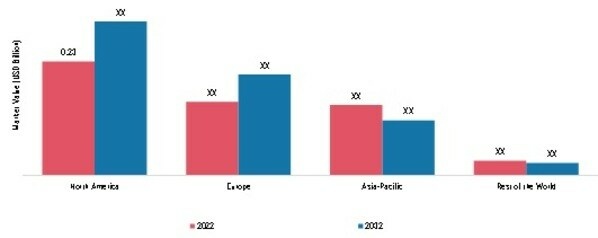Market Analysis
Biomaterial Wound Dressing Market (Global, 2025)
Introduction
The Biomaterials wound dressing market is expected to grow at a CAGR of more than 7%, owing to the increasing prevalence of chronic wounds, surgical procedures, and rising demand for effective wound management solutions. The use of biomaterials wound dressings has increased, as they are used to treat wounds and infections. These advanced wound dressings, which are made of biocompatible materials, not only help in healing but also provide a high level of moisture retention, antimicrobial properties, and ease of use. A wide range of products, such as hydrogels, foams, films, and alginates, is available in the market. In addition, new biomaterials and new technology are in development, which are expected to further enhance the scope of applications and improve patient outcomes. The biomaterials wound dressing market is expected to grow at a CAGR of more than 7%, owing to the increasing prevalence of chronic wounds, surgical procedures, and the growing need for effective wound management solutions.
PESTLE Analysis
- Political
- The 2025 regulatory framework for wound dressings is influenced by government policies aimed at improving the quality of health care. The U.S. Food and Drug Administration (FDA) has recently implemented new guidelines for wound dressings. The new guidelines require clinical trials of wound dressings, with at least 200 patients in each trial, to prove the efficacy and safety of the product. The European Medicines Agency (EMA) has introduced a new directive that requires post-market surveillance for at least five years. This affects the way companies launch new products and enter the market.
- Economic
- The economic environment for the wound dressing market in 2025 will be characterized by rising health expenditures, which are projected to reach $4.5 trillion in the United States alone. This increase in spending is driven by an aging population and the increasing prevalence of chronic wounds. The aging of the population is accompanied by an increase in the prevalence of chronic wounds. In the United States, for example, an estimated 6.5 million people suffer from chronic wounds. The average cost of treating these wounds is about $50,000 per patient, which highlights the economic burden and the need for new wound care solutions.
- Social
- The use of biomaterials for wound dressings is influenced by social factors. In 2025, the knowledge of the benefits of advanced wound care for patients and health care professionals will increase. Surveys show that 78% of health care professionals believe that the use of biomaterials can significantly improve healing compared to the use of conventional dressings. Furthermore, patient education has resulted in a 30% increase in the demand for wound dressings in 2025, because patients are more informed about the possibilities of treatment and the importance of an efficient wound dressing.
- Technological
- Biomaterial wound dressings are undergoing a rapid change. In 2025, 3D printing and nanotechnology will be used to produce a wound dressing that is adapted to the patient’s body. For example, 3D-printed wound dressings can be adapted to the exact dimensions of a wound, which is both more comfortable and more effective. Furthermore, smart wound dressings with sensors to monitor the moisture level and infection will be developed further, so that by the end of the year, about a quarter of all new products will contain these features.
- Legal
- Intellectual property and patent law are increasingly influencing the biomaterial wound dressings market. In 2025, it is estimated that over 1,000 patents on biomaterials and wound care technology will have been filed worldwide. In this highly competitive environment, companies must be able to protect their innovations by means of complex patent law. Furthermore, compliance with international standards such as ISO 13485 for medical devices is compulsory, requiring companies to invest in quality management systems to ensure that their products meet strict safety and performance criteria.
- Environmental
- In the field of wound dressings, the environment is increasingly being taken into account. By 2025, about 40 percent of companies are expected to use sustainable manufacturing methods and use biodegradable materials in the production of wound dressings. According to a survey, 65% of patients prefer to use sustainable wound dressings. Waste disposal regulations and the reduction of plastics in medical devices are also influencing the development of greener alternatives.
Porter's Five Forces
- Threat of New Entrants
- The market for biomaterial wound dressings is characterized by moderate entry barriers. The initial investment in R & D, regulatory approvals and manufacturing capabilities is high, but the growing demand for advanced wound care solutions is attracting new players. Brand loyalty and distribution networks are a threat to new entrants, but technological progress and innovation create opportunities for new entrants.
- Bargaining Power of Suppliers
- The bargaining power of suppliers in the market for biomaterials for wound dressings is relatively low. There are numerous suppliers of the raw materials and components used in the manufacture of wound dressings, which creates a competitive supply environment. Suppliers can also be changed without significant costs, which also reduces their bargaining power. But the supply of specialized materials may give certain suppliers more power.
- Bargaining Power of Buyers
- The buyers of biomaterial wound dressings, such as hospitals, clinics, and health-care facilities, have high bargaining power. With a wide range of products to choose from, they can easily compare prices and negotiate. In addition, the growing focus on cost-effectiveness in health care gives buyers the power to demand lower prices and better quality, thereby fostering a more competitive market.
- Threat of Substitutes
- The threat of substitutes in the biomaterial wound dressing market is moderate. The only alternatives are traditional wound dressings and advanced therapies. But the unique advantages of biomaterial wound dressings, such as healing enhancement and biocompatibility, give them a competitive edge. The only threat is from the constant innovation in the alternative treatments.
- Competitive Rivalry
- Competition in the biomaterial wound dressing market is high, driven by a large number of established players and new entrants. Companies are constantly innovating to develop new products to meet the changing needs of patients and health care professionals. This intense competition leads to price wars, intensified marketing efforts and a greater focus on product differentiation, making the market dynamic and challenging.
SWOT Analysis
Strengths
- Biocompatibility of materials enhances patient safety and comfort.
- Growing demand for advanced wound care solutions drives innovation.
- Increased awareness of chronic wounds and their management supports market growth.
- Strong investment in R&D from key players leads to product diversification.
Weaknesses
- High production costs may limit accessibility for some healthcare providers.
- Regulatory hurdles can delay product launches and market entry.
- Limited awareness among healthcare professionals about new biomaterials.
- Dependence on raw material availability can affect supply chains.
Opportunities
- Rising prevalence of diabetes and obesity increases demand for wound care products.
- Expansion into emerging markets presents growth potential.
- Technological advancements in biomaterials can lead to superior product offerings.
- Partnerships with healthcare institutions can enhance market penetration.
Threats
- Intense competition from traditional wound care products may hinder market share.
- Economic downturns could reduce healthcare spending on advanced solutions.
- Potential for product recalls due to safety concerns can damage brand reputation.
- Rapid technological changes may outpace current product offerings.
Summary
The biomaterial wound dressing market in 2025 is characterized by high growth, owing to the rising demand for advanced wound care solutions and the innovations in biocompatible materials. However, the high cost of production and the high regulatory barriers to entry will limit the market growth. Opportunities exist in expanding into emerging markets and utilizing technological advancements, while competition and economic fluctuations will affect the overall market dynamics. Strategic alliances and a strong R&D strategy will be important for companies that want to exploit the evolving market.






Leave a Comment